What Is Geothermal Energy?
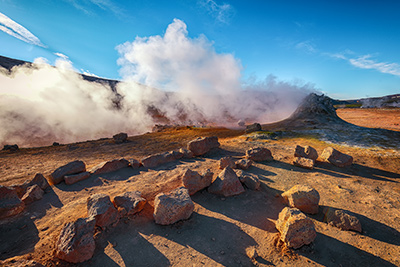
Renewable energy is on the rise, and depending on where you live, you may be noticing more solar panels and wind turbines on the horizon. But while these renewable energy technologies are highly visible, there is another – geothermal energy – that is largely hidden underground.
What Is Geothermal Energy?
Derived from the Greek words “geo,” meaning “earth,” and “therme,” meaning “heat,” geothermal energy is heat energy trapped beneath Earth’s crust. Earth’s iron core is around 10,800 degrees Fahrenheit, and that heat emanates through thousands of miles of magma and rock on its way to Earth’s surface. Fortunately, we don’t have to dig too deep to harvest geothermal energy for heating, cooling and electricity generation.
What Are the Different Types of Geothermal Systems?
According to the U.S. Energy Information Administration (EIA), geothermal energy use falls into three main categories: direct use, geothermal power plants and geothermal heat pumps.
Direct Use of Geothermal Heating
The ease of access to geothermal energy varies by location, and in some areas – near natural hot springs, for example – geothermal energy is abundant very close to Earth’s surface. Where the terrain allows it, geothermally heated water can be pumped directly into buildings to heat air and water, or for various industrial applications. Reykjavik, the capital city of Iceland, uses heat energy from its nearby hot springs to provide geothermal district heating to the vast majority of its homes and buildings.
Geothermal Power Plants
Similar to direct-use geothermal projects, geothermal power plants are located in areas where geothermal energy can be accessed relatively easily. In the U.S., these areas are mostly within the Rocky Mountain and Sierra Nevada regions, where the high temperatures of Earth’s mantle layer are fairly close to the surface. In parts of California, Nevada, Utah, Oregon, Idaho, New Mexico and even Hawaii, utility-scale power plants access this subterranean heat to power steam-driven turbines that generate electricity.
Geothermal Heat Pumps
Unlike the other categories, geothermal heat pumps can be installed and put to practical use in most regions, including throughout most of the U.S. These systems only reach a short distance below the surface, where temperatures remain fairly stable between about 50 and 60 degrees Fahrenheit. They work by circulating water through a series of underground pipes, transferring heat in the process. In the summer, the heat pump absorbs hot air from inside a home or building and transfers the heat to the water, which is then circulated below ground to cool off. And in the winter, when below-ground temperatures are higher than surface air temperatures, the circulating water brings geothermal heat up to the surface to heat homes and buildings.
Is Geothermal Energy Renewable?
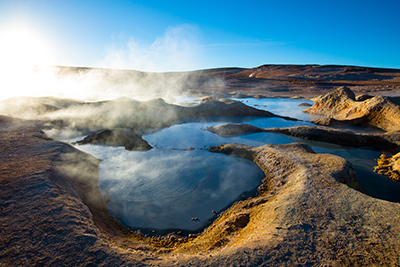
Geothermal Energy Pros and Cons
Additional Advantages of Geothermal Energy:
- Energy independence. Because small-scale applications like geothermal heat pumps can be used throughout much of the world, they grant more energy independence to the international community than fossil fuels such as oil, which is distributed less evenly.
- Smaller facility size. Geothermal power plants get their energy from down below, which means they don’t need to sprawl out the same way wind and solar farms do. A well-placed geothermal power plant can match the energy output of a massive wind or solar farm while occupying a fraction of its footprint.
- Significant potential. The geothermal energy industry is relatively young and limited by the state of its technology, but it’s engaging in constant research and development. Because geothermal energy is accessible virtually everywhere – and at higher temperatures the deeper we can dig – the industry’s future potential with technological advances is enormous.
Disadvantages of Geothermal Energy:
- Site-specific applications. Until new technology paves the way, geothermal power plants and many direct-use projects are limited to those areas where geothermal energy is most accessible.
- Earthquake risk. Geothermal power plants require deep digging, and this affects the tectonic plates below in ways that can increase the probability of earthquakes, similar to fracking.
- High installation cost. While geothermal systems can save money in the long run, the upfront costs of equipment and installation are high. Geothermal power plant construction usually costs millions of dollars, while installation of a residential geothermal heat pump can cost between $10,000 and $30,000.
Looking for Something Specific?
Select a category to find resources for topics that interest you.
Select Category

Related Articles:
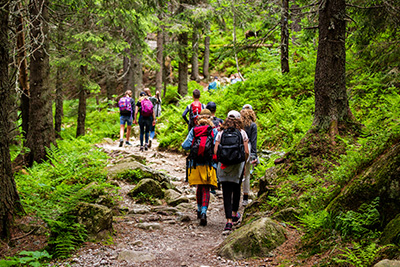
What Are Carbon Offsets?
Carbon offsets help account for the carbon emissions produced by your daily activities. These offsets go toward projects that have a positive impact on the environment, like reforestation or renewable energy production.
Read Article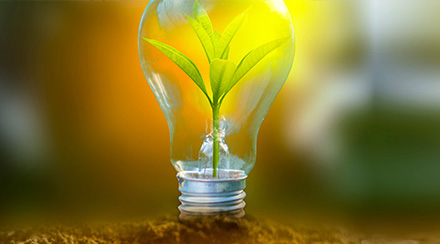
What Is Renewable Energy, or Clean Energy?
It’s easy to think of renewable energy as cutting edge; we often associate it with solar panels and wind farms, and consider it to be the future of energy production. But this is only partially true.
Read Article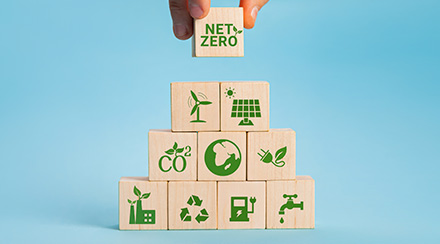
What is a Carbon Footprint and How to Reduce It
We all know some basic steps we can take to safeguard the environment, but some of the most significant changes we can make involve the way we use energy at home.
Read ArticleWhat Is Geothermal Energy?
Renewable energy is on the rise, and depending on where you live, you may be noticing more solar panels and wind turbines on the horizon. But while these renewable energy technologies are highly visible, there is another – geothermal energy – that is largely hidden underground.
What Is Geothermal Energy?
Derived from the Greek words “geo,” meaning “earth,” and “therme,” meaning “heat,” geothermal energy is heat energy trapped beneath Earth’s crust. Earth’s iron core is around 10,800 degrees Fahrenheit, and that heat emanates through thousands of miles of magma and rock on its way to Earth’s surface. Fortunately, we don’t have to dig too deep to harvest geothermal energy for heating, cooling and electricity generation.
What Are the Different Types of Geothermal Systems?
According to the U.S. Energy Information Administration (EIA), geothermal energy use falls into three main categories: direct use, geothermal power plants and geothermal heat pumps.
Direct Use of Geothermal Heating
The ease of access to geothermal energy varies by location, and in some areas – near natural hot springs, for example – geothermal energy is abundant very close to Earth’s surface. Where the terrain allows it, geothermally heated water can be pumped directly into buildings to heat air and water, or for various industrial applications. Reykjavik, the capital city of Iceland, uses heat energy from its nearby hot springs to provide geothermal district heating to the vast majority of its homes and buildings.
Geothermal Power Plants
Similar to direct-use geothermal projects, geothermal power plants are located in areas where geothermal energy can be accessed relatively easily. In the U.S., these areas are mostly within the Rocky Mountain and Sierra Nevada regions, where the high temperatures of Earth’s mantle layer are fairly close to the surface. In parts of California, Nevada, Utah, Oregon, Idaho, New Mexico and even Hawaii, utility-scale power plants access this subterranean heat to power steam-driven turbines that generate electricity.
Geothermal Heat Pumps
Unlike the other categories, geothermal heat pumps can be installed and put to practical use in most regions, including throughout most of the U.S. These systems only reach a short distance below the surface, where temperatures remain fairly stable between about 50 and 60 degrees Fahrenheit. They work by circulating water through a series of underground pipes, transferring heat in the process. In the summer, the heat pump absorbs hot air from inside a home or building and transfers the heat to the water, which is then circulated below ground to cool off. And in the winter, when below-ground temperatures are higher than surface air temperatures, the circulating water brings geothermal heat up to the surface to heat homes and buildings.
Is Geothermal Energy Renewable?
Geothermal Energy Pros and Cons
Additional Advantages of Geothermal Energy:
- Energy independence. Because small-scale applications like geothermal heat pumps can be used throughout much of the world, they grant more energy independence to the international community than fossil fuels such as oil, which is distributed less evenly.
- Smaller facility size. Geothermal power plants get their energy from down below, which means they don’t need to sprawl out the same way wind and solar farms do. A well-placed geothermal power plant can match the energy output of a massive wind or solar farm while occupying a fraction of its footprint.
- Significant potential. The geothermal energy industry is relatively young and limited by the state of its technology, but it’s engaging in constant research and development. Because geothermal energy is accessible virtually everywhere – and at higher temperatures the deeper we can dig – the industry’s future potential with technological advances is enormous.
Disadvantages of Geothermal Energy:
- Site-specific applications. Until new technology paves the way, geothermal power plants and many direct-use projects are limited to those areas where geothermal energy is most accessible.
- Earthquake risk. Geothermal power plants require deep digging, and this affects the tectonic plates below in ways that can increase the probability of earthquakes, similar to fracking.
- High installation cost. While geothermal systems can save money in the long run, the upfront costs of equipment and installation are high. Geothermal power plant construction usually costs millions of dollars, while installation of a residential geothermal heat pump can cost between $10,000 and $30,000.
Looking for Something Specific?
Select a category to find resources for topics that interest you.
Select Category

Related Articles:

What Are Carbon Offsets?
Carbon offsets help account for the carbon emissions produced by your daily activities. These offsets go toward projects that have a positive impact on the environment, like reforestation or renewable energy production.
Read Article
What Is Renewable Energy, or Clean Energy?
It’s easy to think of renewable energy as cutting edge; we often associate it with solar panels and wind farms, and consider it to be the future of energy production. But this is only partially true.
Read Article
What is a Carbon Footprint and How to Reduce It
We all know some basic steps we can take to safeguard the environment, but some of the most significant changes we can make involve the way we use energy at home.
Read Article






